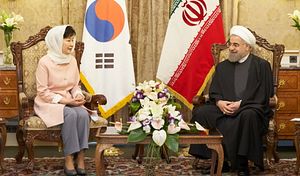One only needs to stroll amid Seoul’s skyscrapers on Teheran Boulevard to understand Iran’s influence on South Korea’s economic development. The East Asian country’s industrial revolution in the 1970s depended strongly on ties in the Middle East with the very conglomerates whose buildings line these streets.
With her recent tour to Iran South Korean President Park Geun-hye has recalled the influence of her father, late strongman Park Chung-hee, who led that revolution, and rewarmed ties with Iran. Park became the first Korean head-of-state to ever visit Iran.
The political climate was precarious, with Iran freshly released from nuclear sanctions and South Korea approaching its volatile northern neighbor’s military ally. But Park was seen pulling off a smooth tour by focusing on economic ties — toting her largest-ever traveling business delegation of over 230 executives, signing $45.6 billion worth of memorandums of understanding, and paving the way for major infrastructure projects — and playing her soft power card to win over Iranians.
The image of Park donning a hijab highlighted South Korea’s openness toward the Muslim community, allowing her to cross barriers as a female leader touring an Islamic country. The timing creates a prime opportunity for Seoul to reinforce its diplomatic image in the Middle East: Park’s show of respect sets the mood for a partner with an ambivalent stance on religions at a time when the world is experiencing a height in Islamophobia.
“Culturally, the soft power is really attracting lots of attention nowadays. This is totally different from political practice in Western countries,” said Haiyun Ma, an assistant professor of history at Frostburg State University.
South Korea, as a democratic, industrial country, has little religious conflict and has worked to develop excellent relationships with the Muslim world, including deploying resources to strengthen ties with Turkey. It is using the same strategy to build a relationship with Iran.
By warming up to its old friends, Park is not directly targeting North Korea’s nuclear disarmament. Expecting Iran to pressure North Korea to give up its nuclear program would be a naive, idealistic effort if Pyongyang’s biggest ally, China, has so far been unable to do so, notes Ma.
While officially calling on Iran to pressure North Korea, Park did not hold out much hope for the Middle Eastern country’s influence on Pyongyang. Instead, Seoul is taking a more indirect route to address the North Korean security challenge. By aiming to strengthen ties with Iran (and Pyongyang’s other allies) through business and soft power, Seoul hopes to to pry loose North Korea’s grip.
“South Korea’s policies are very clear: They want to cut off North Korea’s outside connections by building closer relationships with countries like Iran,” Ma said, adding that cooperating with Iran could help South Korea and other countries get a glimpse of North Korea’s intelligence situation.
Beyond this bilateral effort, the bigger picture reflects Seoul’s aim to expand its diplomatic ties with other middle-power countries — those that are not superpowers but are economically independent, which gives them the freedom to cooperate with more countries than power players do.
South Korea, both geographically and politically sandwiched between big power brokers China and Japan, is an ambivalent player in East Asia that has been building relationships with other middle powers like Indonesia, Mexico, Turkey, and Australia. Those countries are notches in the ally belt from Asia to the Middle East that Park has been building over her term, and she seeks to carve another for Iran, with its growing economy, large population, oil reserves, and newfound political momentum.
The benefit goes both ways. With Iran understanding the importance of the middle power club, it is trying to improve its relationship with Turkey and even enemy Saudi Arabia, Ma notes. That makes South Korea a prime partner not only for Iran, but the overall Middle East, which has adopted a “look East” policy that includes China, Japan, India, and South Korea.
The successful tour not only demonstrates a growing Iran-South Korea relationship, but also opens the doors to more ties in the east, from India to China and Japan., while helping to ease the United States’ wariness. Now that Iran has many cooperation options — such as with China, Russia and Japan — it could easily let go of its partnership with North Korea, Ma said.
If South Korea wanted, he added, it could even help Iran develop its military tech, thus outplaying North Korea’s high card.
“Obviously there’s much potential for the two countries to cooperate in the future,” Ma said.

































